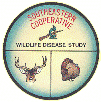Southeastern Cooperative Wildlife Disease Study

Southeastern Cooperative Wildlife Disease Study: Publications
Document Type
Article
Date of this Version
April 2004
Abstract
• First Culture of the STARI Agent for Lyme disease, caused by Borrelia burgdorferi sensulato, the most common tick-borne disease of humans worldwide and the most frequently reported vector-borne disease in the United States.
• Unusual wild elk mortality that began in late January to early February 2004 in the Red Rim area southwest of Rawlings, Wyoming, has been preliminarily diagnosed as lichen (Xanthoparmelia chlorochroa) toxicosis.
• During 2003, hemorrhagic disease (HD) was documented in seven states through virus isolation at SCWDS. Most of our isolations were associated with an outbreak in western Idaho and adjoining eastern Washington. Both epizootic hemorrhagic disease virus (EHDV) and bluetongue disease virus (BTV) were found.
• Recently, in collaboration with Dr. Jim MacLachlan’s research group at the University of California, Davis, we sequenced a large number of our EHDV-2 and EHDV-1 isolates for phylogenetic analysis. This work was done by Dr. Molly Murphy, a recent SCWDS PhD graduate.
• Since 1998, personnel with the West Virginia Wildlife Resources Division have received sporadic reports from the public regarding whitetailed deer with extensive hair loss. Case histories indicated that variable amounts of supplemental deer feeding with shelled corn occurred at most of the locations where affected deer had been reported.
• Pseudorabies and Brucellosis Problems in Feral Swine
• Dr. David Stallknecht recently received the Pfizer Award for Research Excellence at the University of Georgia’s College of Veterinary Medicine.

